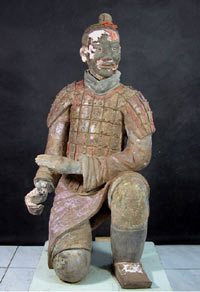
Handy Links
SLAC News Center
SLAC Today
- Subscribe
- Archives: Feb 2006-May 20, 2011
- Archives: May 23, 2011 and later
- Submit Feedback or Story Ideas
- About SLAC Today
SLAC News
Lab News
- Interactions
- Lightsources.org
- ILC NewsLine
- Int'l Science Grid This Week
- Fermilab Today
- Berkeley Lab News
- @brookhaven TODAY
- DOE Pulse
- CERN Courier
- DESY inForm
- US / LHC
SLAC Links
- Emergency
- Safety
- Policy Repository
- Site Entry Form

- Site Maps
- M & O Review
- Computing Status & Calendar
- SLAC Colloquium
- SLACspeak
- SLACspace
- SLAC Logo
- Café Menu
- Flea Market
- Web E-mail
- Marguerite Shuttle
- Discount Commuter Passes
-
Award Reporting Form
- SPIRES
- SciDoc
- Activity Groups
- Library
Stanford
Around the Bay
Ancient Warriors and the Origin of Chinese Purple
 In 1974, while sinking irrigation wells in the Chinese province of Shaanxi, a group of farmers made an astonishing archeological discovery. Buried beneath their feet stood a contingent of 8,000 life-sized terra cotta warriors and their horses, facing east, ready for battle. The figures, later found to be more than 2,000 years old, were accompanied by weapons, real chariots, and objects of jade and bone. It was later determined that this army was built to protect the tomb of the first emperor of the Qin dynasty, Shi Huang Di.
In 1974, while sinking irrigation wells in the Chinese province of Shaanxi, a group of farmers made an astonishing archeological discovery. Buried beneath their feet stood a contingent of 8,000 life-sized terra cotta warriors and their horses, facing east, ready for battle. The figures, later found to be more than 2,000 years old, were accompanied by weapons, real chariots, and objects of jade and bone. It was later determined that this army was built to protect the tomb of the first emperor of the Qin dynasty, Shi Huang Di.
Today many puzzles still surround these statues. One of the most intriguing of these mysteries is the origin of a synthetic purple pigment, often called "Chinese purple" or "Han purple," that their ancient creators used to adorn the soldiers and their accessories. Now, using advanced x-ray techniques, researchers at Stanford Synchrotron Radiation Laboratory (SSRL) have unraveled a major piece of this puzzle.
Until the 19th century, most pigments were made from naturally occurring minerals or organic dyes. One well-known exception is "Egyptian blue," which is chemically very similar to the Chinese purple. Because the Egyptian and Chinese pigments are so chemically close in composition, some have proposed that the technology to create Chinese purple was in fact derived from the Egyptians. If that were so, Chinese purple would represent one of the earliest known cases of cross-cultural technology transfer, dating to a period before the Silk Road opened China to the west, even before the invention of paper or the compass.
To test this hypothesis, SSRL researchers Zhi Liu, Apurva Mehta and colleagues from Stanford, Berkeley Lab's Advanced Light Source and China used a series of synchrotron-based x-ray techniques to characterize the exact chemical make-up of the pigments in Chinese purple. Liu found that deep within the structure of Egyptian blue, calcium plays a key role in the pigment's molecular identity, whereas in Chinese purple, that same slot is filled by the element barium. Liu concluded that, based on this difference, and despite the two pigments' structural similarity, Chinese artisans invented Chinese purple independently of Egyptian influence.
"Stable purple is rare in nature," Liu said. "People already knew what the pigment was, but by making a chemical map and combining it with archeological evidence, we were able to solve the puzzle of where it came from."
Scholars believe that Chinese alchemists 2,200 years ago were most interested in synthesizing jade, a mineral regarded as sacred in Taoist culture. Liu's analysis found that, based on the combination of compounds used to make the pigment and the technologies available to Chinese artisans at the time, Chinese purple was most likely first developed by Taoist glassmakers attempting to create artificial jade. The results of this study will appear in an upcoming issue of the Journal of Archaeological Science.
óBrad Plummer, February 6, 2007
Above image: Samples of a pigment called Chinese purple were obtained from this kneeling archer, one of 8,000 terra cotta warriors discovered in 1974.
Researcher's note: This research was partially funded by the France-Stanford Centre for Interdisciplinary Studies.